Table of Contents
🎯 What Are Goals?
Goals are the outcomes we want and try to achieve.
👍 Why Set Goals?
1 Focus
Without goals, we’re like a hiker with no map: it’s unclear where we’re going or how we’ll get there. Goals help focus our attention on what we want to achieve.[1]
But a map is only as useful as its detail.
A good map is specific and avoids ambiguity. The same is true for goals. Vague goals like “I need to do my best” fail because the outcome isn’t clear; there’s nothing concrete to focus our attention on.[2]
2 Flow
Goals encourage us to work harder for longer.
- We work harder because we’re more motivated – by setting goals that inspire us we’re more willing to put in the effort to achieve them.
- We work longer because we enter the flow state[3] – good goals are challenging, yet within our skill level. This is ideal for getting ‘in the zone’ and fully immersing ourselves in our work.
3 Fight
Goals are a crutch for consistency. When there’s a setback, we’ll want to give up unless there’s a good reason to continue. Goals give us this reason.[4]
They make us fight when we’re flailing.
4 Form
We set goals because we’re imperfect. There’s something about who we are or what we’re doing that we want to change.
It’s this gap between our real self (i.e. who we are) and our ideal self (i.e. who we want to be) that goals help to close.[5] By closing the gap we build self-confidence, strengthen our character, and change who we are as individuals.
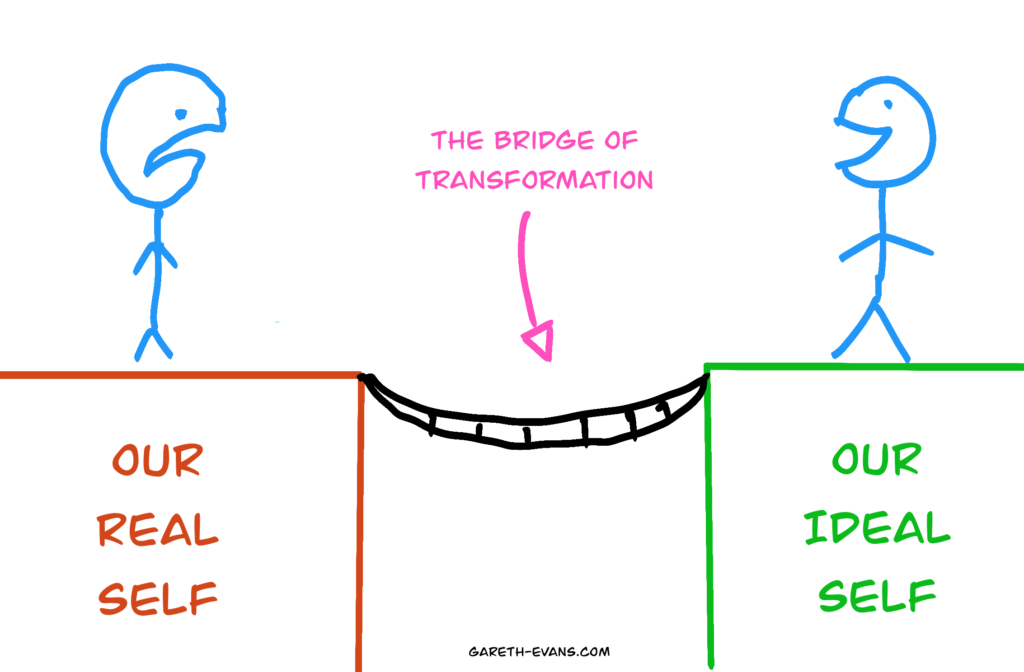
👎 Limitations of Setting Goals
1 Tunnel Vision
When all our focus is on achieving a set goal, we miss opportunities to learn skills or gather useful information.
The ‘selective attention test’ is a brilliant example of how we ignore information when it isn’t aligned with our goal. Try it out:
Solution: Learning Goals
To avoid focusing too narrowly on a given goal, we can also set learning goals.[6]
Learning goals are general goals to build knowledge in a certain topic. For example:
- “Learn how to be the best lawyer/doctor/whatever in my area of practice.”
- “Find ten ways of developing deeper relationships with our customers.”
These learning goals remind us to broaden our focus on things outside our core goals. Like, opportunities to improve our skills and tackle personal weaknesses, biases, or oversights.
E.g. Coca-Cola’s 1985 goal to improve their taste to compete with Pepsi may have succeeded if they’d also set a learning goal to “better understand the needs of our target market”.
2 The Hedonic Treadmill
Goals create an “either-or” conflict:
- EITHER we achieve our goal and think we’re successful
- OR we don’t and think we’re a failure.
Our happiness and self-worth, then, is tied to our ability to complete our goals.
For example, we tell ourselves stuff like “once I pass my exam, I’ll be happy” or “once I lose 10kg, I can relax”. But, all we’re doing is making happiness something our future self enjoys. Not us, right now.
Plus, the happiness we get from achieving our goals is brief. This is because of the ‘hedonic treadmill’: our happiness always returns to a relatively stable baseline of happiness.
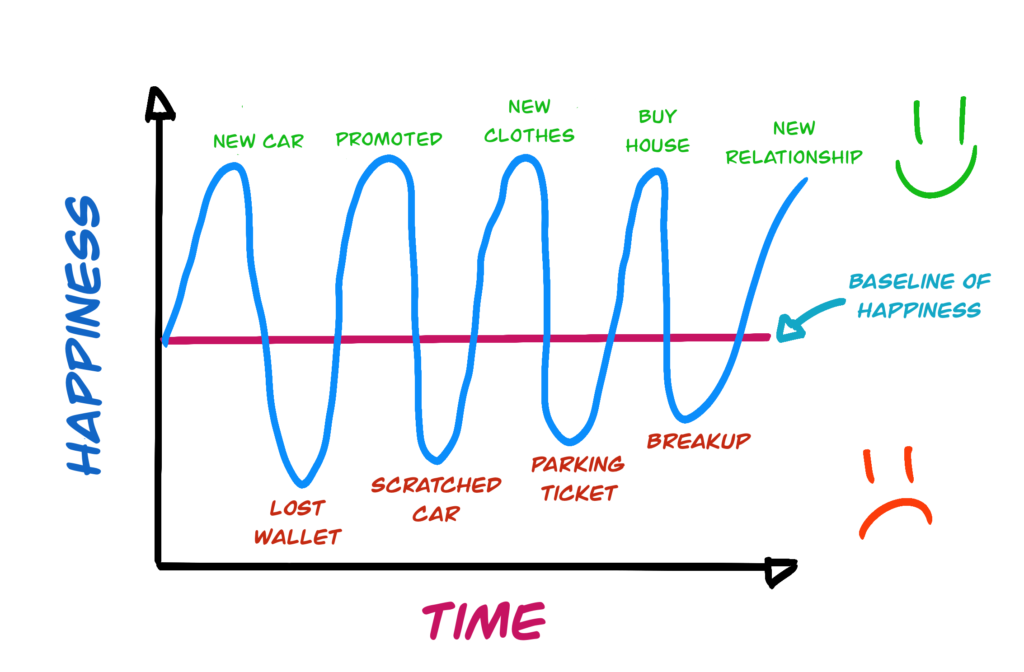
Even our greatest goals probably won’t make us happy for long. Buzz Aldrin, the second man on the moon, was sad and alcoholic after achieving his dream as he’d lost his sense of purpose. As he put it: “What’s a person to do when his or her greatest dreams and challenges have been achieved?”
Solution: Enjoy the Journey
Achieving our goals will never make us 100% happy. Instead, we need to enjoy every part of the journey: the good and the bad.
The journey is where you learn. Where you grow. Where memories are made.
The doing is often far more important than the outcome.
3 Overstretching
If our goals are too hard they scare us. We fear we might fail. It’s this fear of failure that makes us work less on hard goals.
Where there’s pressure on us to achieve hard goals we may act dishonestly. For example, a call centre set a goal for employees to keep their call length under two minutes. The result: as soon as someone answered the phone, they hung up.[7]
Solution: Framing
Goals only scare us when we frame them as being an impossible challenge. Instead, we should frame our goals as an achievable challenge.
As Adidas say, “impossible is nothing”.
4 Ceilings
Most people set ceiling goals i.e. goals that express the greatest expected result of our actions. For example, “I’m going to do 100 pressups” is a ceiling goal.
The problem is, once we achieve ceiling goals we’re happy to relax or stop.
Like, if we hit our monthly sales target a week early we’ll likely spend the rest of the month watching Netflix rather than working to sell more. Or, if we’ve hit our daily passenger goal as a taxi driver, we’ll go home even if people still need a ride.[9]
Solution: Floors
Better goals are framed as floor goals i.e. goals that express the least expected result of our actions. For example, “I’m going to do at least 100 press-ups” is a floor goals.
That way, our impulse is not to stop or relax when we achieve our goal. Instead, we challenge ourselves. We see how far beyond our goal we can go.
This is how we improve.
✍️ How To Set Effective Goals?
The way we set goals impacts our chances of goal success. Good goal setting then should motivate action and encourage persistence.
1 Set Inspiring Goals
An inspiring goal is one we commit to because of its attractiveness and our belief we can achieve it.
Commitment
Goals are useless unless we stick with them. And typically this means making goals desirable (i.e. attractive) and within our skill level (i.e. believable).[10]
But, in truth, this is an over-simplification. Like, running a marathon may be an attractive and believable goal, but this doesn’t guarantee we’ll be inspired by it.
This is because many social factors are at play too[11]:
- Previous failures discourage us from our goals
- Higher personal self-esteem helps with goal performance
- We attach different levels of self-worth to our goals
- The sunk cost effect – we don’t want to waste time/energy already spent on a goal, so we stick with it.
So goals that inspire one person won’t necessarily inspire another.
Attractiveness
If our goals meet our needs, they’re attractive[12]. So, falling asleep or eating food is rarely a problem as they meet our basic needs to prevent hunger and fatigue. But writing an essay is rarely seen as something we need to do unless the deadline is tomorrow.
The problem is most of us choose goals that are attractive in the short-term. Like, choosing a job because of the pay and not the work we’ll have to do. So, think about the short- and long-term attractiveness of a goal.
We’ll also find a goal more attractive if we’re enjoying a secondary activity that comes from pursuing that goal.[13] For example, we’ll stick with our gym routine if we also enjoy the social interactions of being a gym member.
Belief
Finally, we need to believe we can achieve our goals. This is called self-efficacy.
2 Set Minimal Goals
Nobody can tell you how many goals to set. It depends on how easy and related those goals are.
But, in general, setting less goals is better.
James Clear makes a good analogy here:
Our lives are like rose bushes. As a rose bush grows, it creates more buds than it can sustain. If you talk to an experienced gardener, they will tell you that rose bushes need to be pruned to bring out the best in both their appearance and their performance. In other words, if you want a rose bush to thrive, then you need to cut away some of the good buds so the great ones can fully blossom.
3 Set Periodic Goals
Our goals must be periodic: short-term and regularly updated.
Short-Term
Our motivation to work on our goals increases exponentially as the deadline nears. This is called Temporal Motivation Theory.[14]
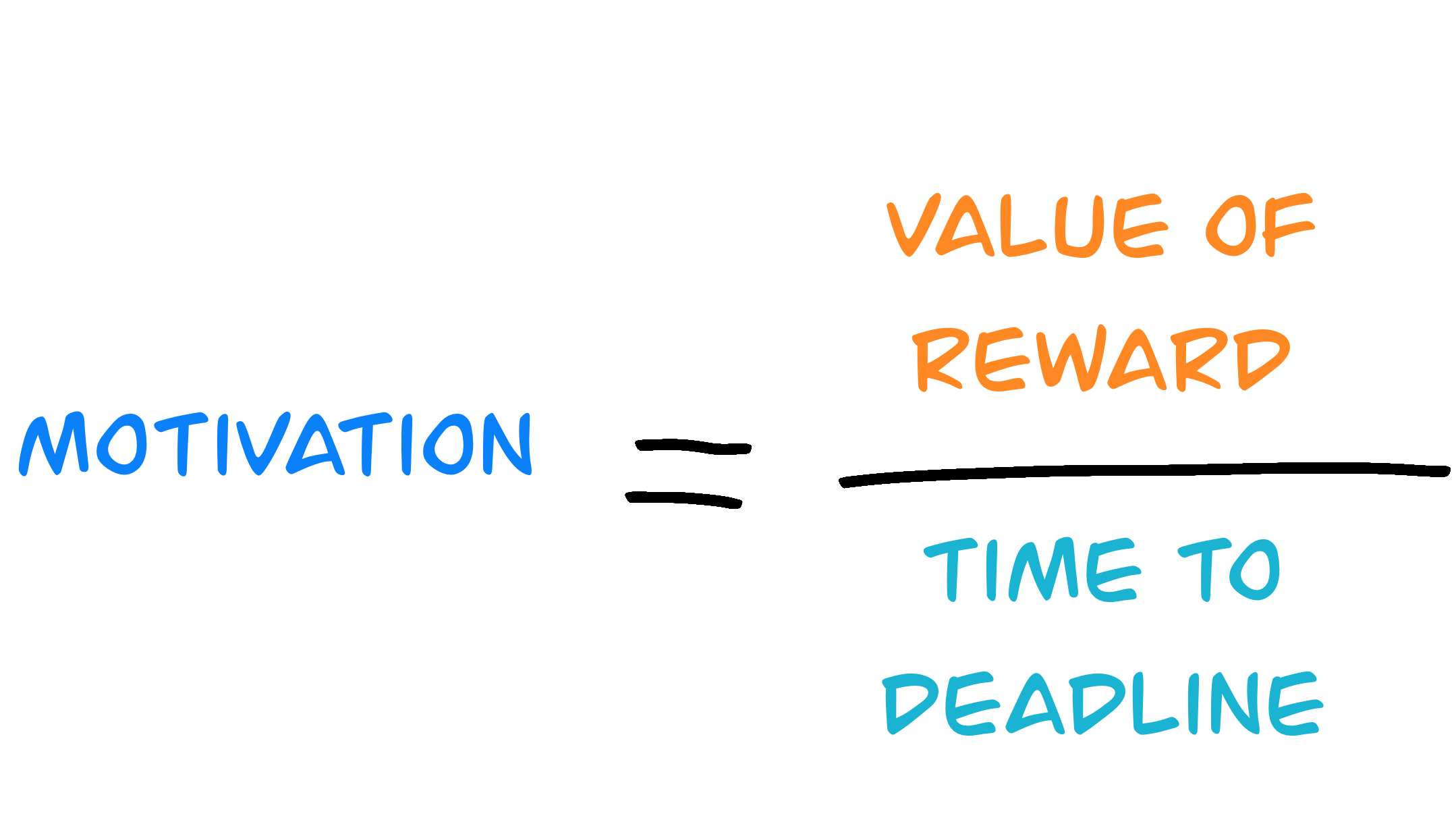
For example, if we’ve got an exam in one month we can choose to study or socialise. Initially, the reward of studying isn’t immediate, so we’ll be more motivated to socialise. But, as our exam approaches, we’ll be more motivated to study.
So, shorter-term goals motivate the right actions.
Regularly Updated
Short-term goals force us to set new goals often. This is good.
First, this allows us to continually re-evaluate and adapt to changing circumstances. Our needs, abilities and knowledge are always changing, so keeping goals fixed long-term isn’t ideal.
Second, by regularly updating our goals we bring the goal reference point closer. So, each action taken towards our goal is noticeable progress. This progress motivates us. For example, running 100m will motivate us more where our goal is to run 1km instead of 10km.
4 Set Appraisable Goals
An appraisable goal is one where we can easily track whether or not we’re taking the right actions.
For example, we can’t just say “I want to pass my exam” as progress towards that goal is unclear. Instead, we need to say something like:
“I want to study for 1 hour every day for the next 4 weeks.”
Basically, we want a “yes” or “no” approach to goal tracking. Have we done the thing or not? That way we can quickly see if we’re doing the right things to achieve our goal. Read more on tracking goals.
5 Set Clear Goals
The clearer our goals, the more persistent and motivated we are to achieving those goals.[15]
So, how do we set clear goals?
- Make them appraisable
- Write them down[16]
- Be unambiguous
- Break them down
6 Set Tough Goals
Surprisingly, the harder the goal the better we perform. As long as it’s within our skillset and feels achievable.
Hard goals energise us as they often imply more significant achievements. Easy goals, on the other hand, bore us as they require little skill.
Although, be careful not to overstretch.
Summary: Set IMPACT Goals
Inspiring – set attractive goals.
Minimal – set few goals.
Periodic – set short-term goals.
Appraisable – set trackable goals.
Clear – set specific goals.
Tough – set hard but achievable goals.
E.g. “I want 3000 YouTube subscribers by March 1st 2022 (Inspring, Minimal, Periodic). To do this, I’ll upload 1 new video each week by creating content each evening from 7pm-9pm after I’ve eaten dinner….” (Appraisable, Clear, Tough)
🤓 How to Stick With Our Goals
Setting great goals is only half the battle. We also have to stick with them. There’s no point having goals if we give up within a week.
Sticking to our goals involves three things:
- Goal Hierarchies
- Systems Thinking
- Environmental Control
1 Goal Hierarchies
We stick to goals that are meaningful i.e. goals that connect to the high level things we want from life long-term, and not just right now. It’s hard to stick to goals if we don’t care about them.
This is why we need to build levels to our goals:
- Level 1: Values → write down the broad goals you want from life and any personal values that are important e.g. “I want to be financially stable”, “I want to be healthy”, “I want awesome relationships with friends and family”.
- Level 2: Goals → the goals we set ourselves should be based on our values. So, if we value “being healthier” then our level 2 goal could be “I want to lose 10kg by June 1st”. These goals are set using the process outlined above.
- Level 3: Actions → finally, our goals must be broken down into actionable systems, outlined below. In other words, the steps to achieving the goal must be clear e.g. “I want to lose 10kg by June 1st by going to the gym 3 times per week (Monday, Wednesday and Saturday after dinner) and eating 2000 calories per day (all meals are prepped on a Sunday at 1pm)”.
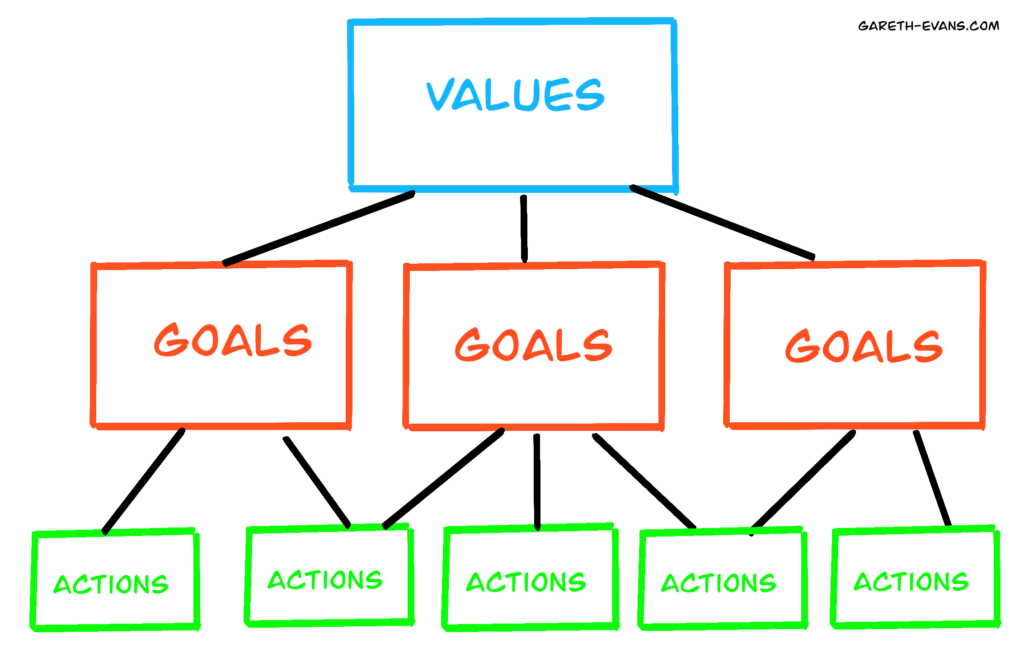
2 Systems Thinking
The main benefit of setting goals is to tell us the system we need. As it’s the system that will achieve the goal.
For example, setting a goal to “be less stressed” tells us nothing about how to achieve it. It’s the system – meditating daily for 20 minutes and writing in our journal before breakfast – that gives us what we want.
So, once we set a goal, there’s one thing we must do: refine it. Be as specific as we can about how, where, and when we’ll take actions to achieving our goal.
Examples:
- I’ll go for a run for at least 20 minutes on Monday and Thursday at 6pm at the gym on the treadmill.
- I’ll meditate for at least 10 minutes every morning at 10am in my bedroom.
- I’ll [do a specific activity] on [a specific day] at [a specific time] in [a specific place].
These plans are called implementation intentions because they clearly state where, when and how we’ll implement a specific behaviour.[17]
3 Environmental Control
It’s hard to stick with our goals in a negative environment. Like, writing an article is hard if the TV is on, there’s a kid screaming next door, and we’ve got no light. In this scenario most of us would stop working or procrastinate.
The impact of our environment on our decisions is called choice architecture. Luckily, there are many way we can use choice architecture in our favour:
- If we want to exercise in the morning we can leave our kit prepared by our bed the previous night and write a quick gym routine. The environment makes it easier to workout.
- If we want to drink more, we can carry a water bottle with us.
- If we want to avoid social media, we can turn off notifications or put our phone in another room.
Almost every bad action we take is due to bad environmental control.
✅ Tracking Our Goals
Goal progress is never linear. This makes tracking progress difficult.
For example, if our goal is to run a marathon, is it 50% complete when we reach mile 13 out of 26? No. There’s been a lot of prior training to just get to the start line.
The truth is, any metrics used to track progress are often unhelpful and inaccurate. Instead, it’s far better to track actions rather than progress – by taking the right actions consistently, we’ll achieve our goals.
The best way to track action is by using a “yes” or “no” approach to goal tracking. If you’ve done the thing on a specific day, you mark it as done. If not, you leave it blank e.g. if my goal is to read daily for 30 minutes, I can check it off on a page like this:
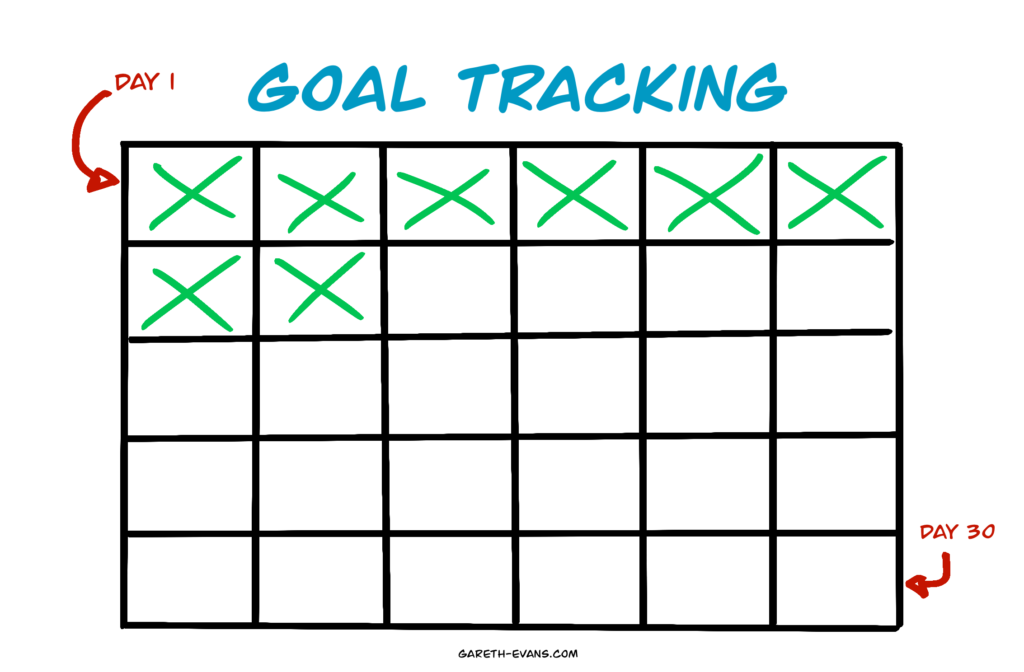
Alternatively, we can use something like Github’s contribution graph or Steph Smith’s Progression Page. There’s loads of great tools out there that let us track our daily actions when working towards our goals.

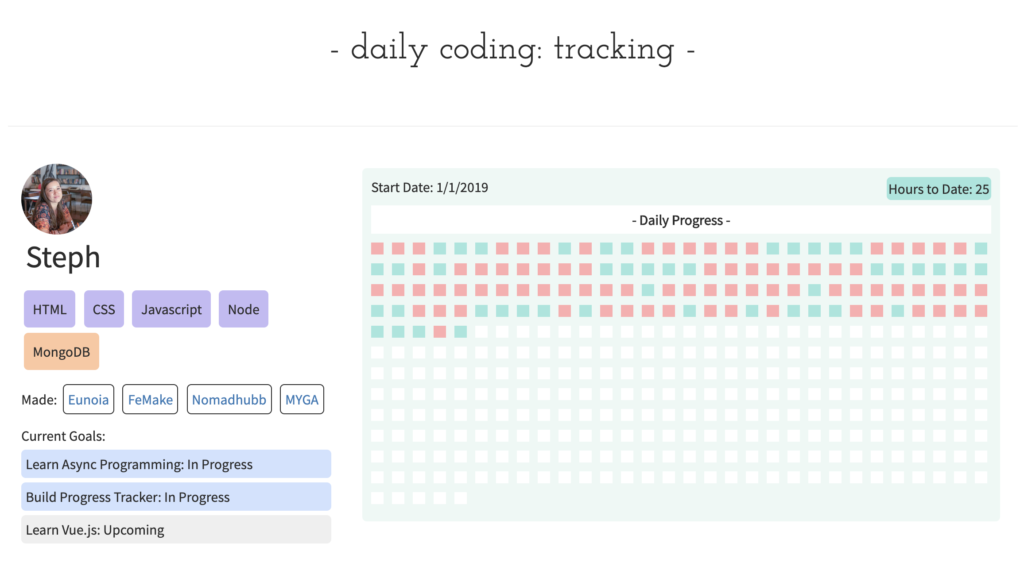
🧭 Goals as a Compass
Goals are an important part of getting what we want out of life. But, goals are never a guarantee of success. This is why we shouldn’t let our sense of self-worth revolve around them.
The right way to think about goals is like a compass taking us to buried treasure: once we’ve set the target, focus on the direction. In other words, when we set a goal, we don’t need to obsess over it. The important thing is to just take the right actions to get there. If we’re doing that, that’s enough as that’s all we truly control.
❤️ FREE Resources
I’ve created a Notion Template called ‘The Ultimate Guide to Goal Tracking’ that you can download for FREE by signing up to my weekly newsletter:
Once you’ve confirmed your email, you’ll be directed to the template. Feel free to unsubscribe from my newsletter at any time! 😁
Here’s a sneak peek of the template:


